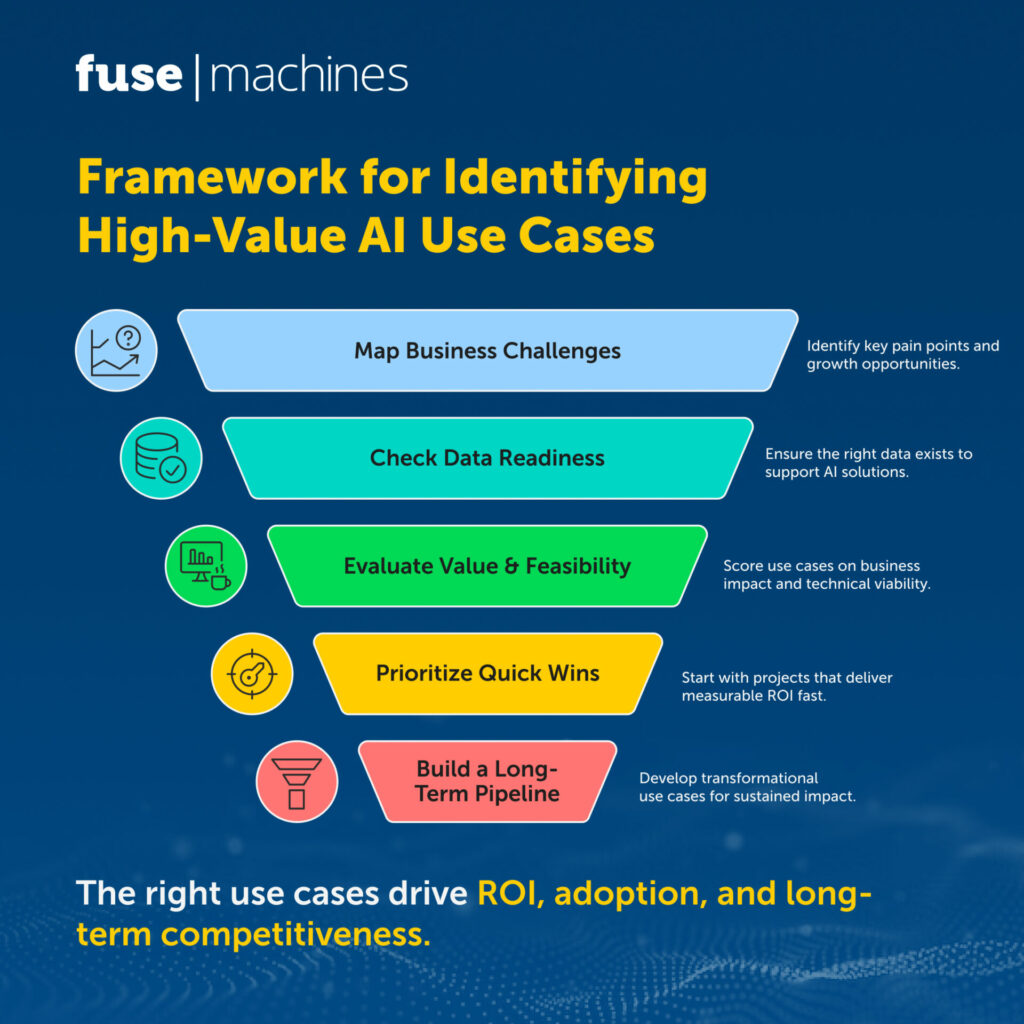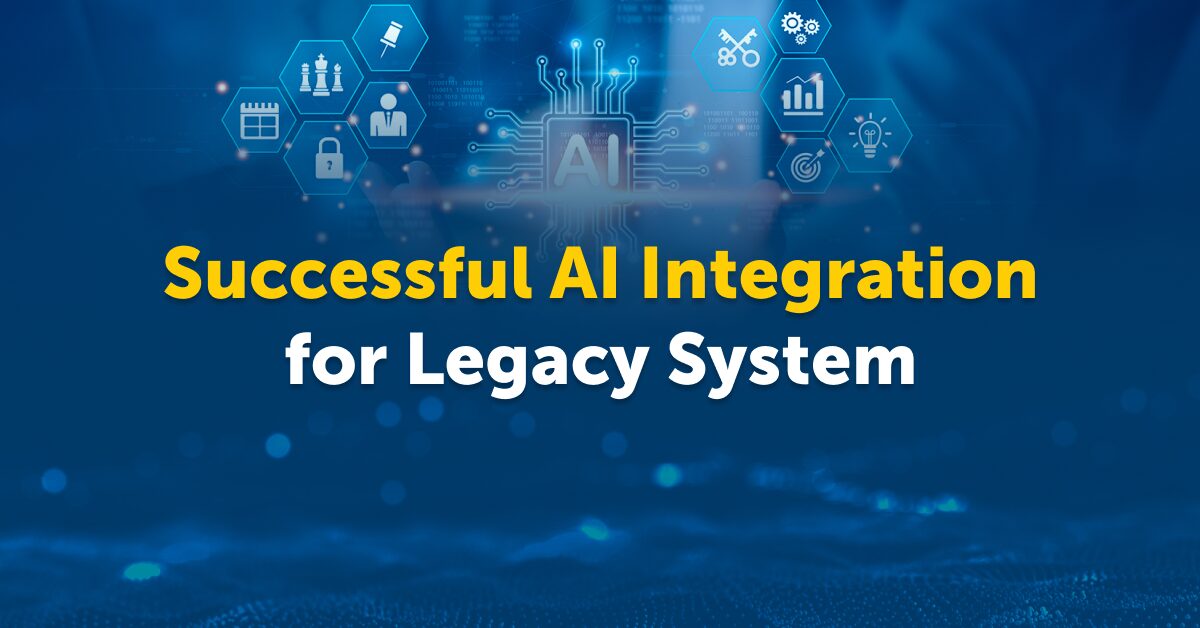How to Identify High-Value AI Use Cases in Your Business

AI adoption is accelerating across industries, yet many organizations still struggle to achieve consistent impact. The challenge often lies not in access to technology, but in selecting the right opportunities to pursue. Choosing use cases that align with business priorities and deliver measurable results is one of the most important factors in determining the success of an AI program.
Effective use case selection ensures that resources are directed toward projects that matter most, builds organizational confidence in AI, and creates a foundation for scaling adoption. For decision makers, it provides a roadmap to focus on opportunities that drive value while avoiding investments that overpromise and underdeliver.
This blog explores a practical framework for identifying and prioritizing high-value AI use cases, helping executives focus on initiatives that strengthen competitiveness and deliver sustainable ROI.

Want guidance from an AI expert on how to implement AI in your business? Contact Fusemachines today!
The Cost of Choosing the Wrong Use Cases
When organizations pursue AI projects without a clear framework, the risks are significant. Misaligned investments can result in wasted budgets, stalled initiatives, and resistance from employees. Projects that do not address real business needs often fail to gain traction, creating skepticism about AI’s value and slowing adoption.
The lesson is clear: success depends on starting with the right use cases, not just any use cases.
Criteria for High-Value AI Use Cases
High-value use cases typically share a few essential qualities:
- Business impact: Does the use case drive revenue, reduce costs, or improve efficiency?
- Feasibility: Does the organization have the necessary data and technical resources?
- Scalability: Can the solution be extended across multiple functions?
- Strategic alignment: Does it support the organization’s goals and customer needs?
These criteria help leaders move beyond hype and identify opportunities that can make a measurable difference.

Download our AI Use Cases to learn more about how you can select the best for your industry.
A Framework for Identifying AI Use Cases
Step 1: Map Business Pain Points and Opportunities
The starting point should always be the business, not the technology. Leaders should identify where inefficiencies, bottlenecks, or customer challenges create the greatest pain. These areas often reveal opportunities where AI can deliver meaningful results.
Examples include retailers struggling with inventory forecasting, financial firms facing delays in loan processing, or manufacturers dealing with frequent equipment downtime. The goal at this stage is to build a comprehensive list of challenges and opportunities before thinking about solutions.
Step 2: Assess Data Readiness for Each Opportunity
AI depends on data quality and accessibility. Before committing to a project, organizations need to examine whether the right data exists and whether it can be used effectively.
Questions to consider include:
- Is the data accurate and complete?
- Can it be accessed across departments, or is it locked in silos?
- Does its use comply with privacy and regulatory requirements?
Recognizing data gaps early helps organizations avoid investing in use cases that are not yet feasible and highlights areas where foundational improvements are needed.
Step 3: Score Use Cases by Value and Feasibility
Once opportunities are mapped and data readiness assessed, each use case should be scored along two dimensions: business value and feasibility.
- High value, high feasibility: Prioritize for immediate execution.
- High value, low feasibility: Prepare the groundwork before launching.
- Low value, high feasibility: Consider as quick wins but monitor impact.
- Low value, low feasibility: Eliminate or postpone.
Even a simple scoring system can help leaders communicate priorities clearly across the organization and focus attention on the most promising projects.
Step 4: Prioritize Quick Wins to Build Momentum
Early success is vital to building confidence and encouraging adoption. Quick wins are projects that are relatively easy to implement, deliver measurable ROI within a short timeframe, and create momentum for more complex initiatives.
Examples include chatbots to reduce call center volumes in retail, fraud detection models in finance, or AI vision systems for quality checks in manufacturing. These projects create visible results that can be shared with employees, investors, and customers, paving the way for more ambitious programs.
Step 5: Create a Pipeline of Long-Term, Transformational Use Cases
Quick wins are important, but they should be balanced with longer-term initiatives that have the potential to transform the business. These projects often take more time and resources but create lasting competitive advantages.
Examples include AI-driven diagnostic tools in healthcare, intelligent credit scoring for financial inclusion, or fully automated supply chains in logistics. Leaders should view the pipeline as a portfolio that balances near-term ROI with long-term innovation.

Common Mistakes to Avoid
Even with a strong framework, many organizations fall into predictable traps that can undermine AI adoption. Recognizing these pitfalls early can save time, money, and organizational trust.
- Chasing novelty instead of value
It is tempting to pursue AI projects because they showcase advanced technology or mirror what competitors are doing. The problem is that novelty-driven initiatives often fail to solve pressing business problems. Leaders should resist hype and evaluate each project against measurable business outcomes. - Overlooking governance and compliance
Governance is not just a regulatory requirement; it is a trust factor. Projects that do not consider issues such as bias, explainability, or data privacy can damage a company’s reputation and expose it to legal risk. High-value use cases must be paired with clear oversight structures and ethical standards. - Working in silos
AI adoption cannot be confined to a single department or technical team. Without cross-functional involvement, projects may solve isolated problems but fail to scale across the business. Building AI into core processes requires collaboration across IT, operations, finance, HR, and leadership. - Neglecting change management
AI can reshape workflows, which may cause fear or resistance among employees. Failing to prepare the workforce for these changes often results in low adoption rates. Communication, training, and leadership sponsorship are essential for success.
By acknowledging these mistakes upfront, leaders can ensure their AI journey is strategic, sustainable, and resilient to common setbacks.
Industry Examples of High-Value Use Cases
High-value AI use cases look different across industries, but they all follow the same principle: solving critical problems with measurable impact.
- Retail
Retailers often face thin margins and fluctuating demand. AI-powered demand forecasting reduces stockouts and minimizes overstocking, while personalized promotions improve customer loyalty. These use cases not only boost revenue but also optimize supply chain efficiency. - Finance
In financial services, AI is transforming risk management and customer trust. Credit scoring models that integrate non-traditional data can expand lending to underserved populations. Fraud detection systems reduce losses by flagging anomalies in real time. Both improve efficiency while strengthening customer confidence. - Manufacturing
Manufacturers are using AI for predictive maintenance, which minimizes costly downtime by addressing issues before they escalate. Automated quality control powered by computer vision enhances accuracy on production lines, reducing waste and improving consistency. These use cases directly impact profitability and customer satisfaction. - Healthcare
AI is reshaping healthcare through diagnostic support tools that assist physicians and patient risk prediction models that flag potential complications earlier. Workflow automation reduces administrative tasks, allowing medical professionals to focus more on patient care. These applications balance efficiency with better outcomes.
Each of these examples demonstrates how AI can deliver value when applied to well-defined business problems. Leaders should use them as inspiration to identify where similar principles apply in their own industries.

Download our AI Use Cases to learn more about how you can select the best for your industry.
Building an Executive Playbook for Use Case Selection
For executives, the challenge is not just identifying high-value use cases but institutionalizing the process so it becomes part of how the organization operates. An effective executive playbook should include:
- Governance and oversight
Create a decision-making framework for evaluating AI initiatives. This might include an AI council or a cross-functional review board that ensures alignment with strategy, compliance, and ROI expectations. - Balanced portfolio management
Treat AI use cases like an investment portfolio. Balance short-term quick wins that deliver fast ROI with longer-term bets that have transformative potential. This mix creates momentum while positioning the business for sustained growth. - C-suite sponsorship
Senior leaders must be actively involved in defining priorities and ensuring projects receive the right resources. Without visible sponsorship, AI projects risk being perceived as side initiatives rather than strategic drivers. - Continuous review
AI maturity is not static. Business needs evolve, and so do data capabilities and regulatory environments. Regularly review and refresh the AI pipeline to stay aligned with changing conditions.
By institutionalizing these practices, executives can ensure that AI adoption is not a one-off initiative but a disciplined, repeatable process that drives lasting results.
Conclusion: Driving ROI Through Smart Use Case Selection
The difference between projects that succeed and those that stall often comes down to AI use case selection. Businesses that start with hype-driven initiatives risk wasted investment and diminished trust. Those that apply a structured framework identify opportunities that are feasible, scalable, and aligned with strategy.
Mapping pain points, assessing data readiness, scoring feasibility and value, prioritizing quick wins, and planning for transformational initiatives creates a clear path to ROI. Leaders who build an executive playbook around these principles will position their organizations to capture both short-term gains and long-term competitive advantage.

Want guidance from an AI expert on how to implement AI in your business? Contact Fusemachines today!


